I have been quite annoyed at having to buy grafted apple trees for our mini orchard. It goes right against our seed saving, grow your own ethos.
However I know enough to realise that apples grown from pips do not grow true (being a hybrid of the tree and the pollinator), they also grow far too high making the fruit near impossible to pick. So I want to have grafted trees, its the whole paying for them thing I struggle with.
The only solution is to learn to graft our own.
I like an MM106 root stock on our apple trees. It grows a largish (12 foot) apple tree but keeps it manageable.
So I bought a few of these (and learned how to produce more, which I will cover in a separate post). You can get them for about £1.50 delivered though, so buying them is a lot cheaper than a £20 grafted fruit tree.
Here is how I went about grafting. I am using the whip and tongue graft here, but I will do some with a saddle graft if anyone is interested.
Step 1
Find a nice healthy apple tree with roughly pencil thick branches. This is best done in March as the tree wakes up
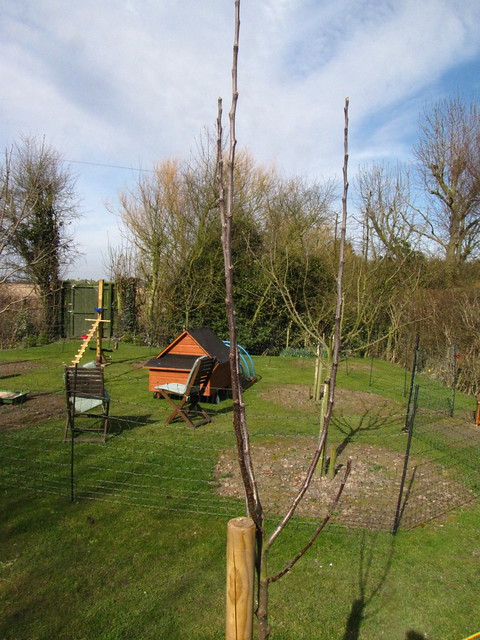 Apple Tree by British Red, on Flickr
Apple Tree by British Red, on Flickr
Step 2
With clean, disinfected secateurs, cut some of the branches of the tree you want. These are known as scions.
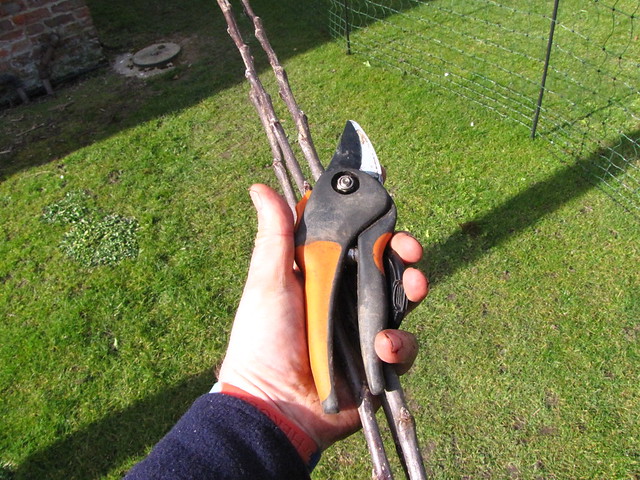 Cut Scions by British Red, on Flickr
Cut Scions by British Red, on Flickr
Step 3
Get your root stock of choice (mine have been stored planted in moist compost) and a very sharp, thin bladed knife. An opinel is perfect. Again disinfect.
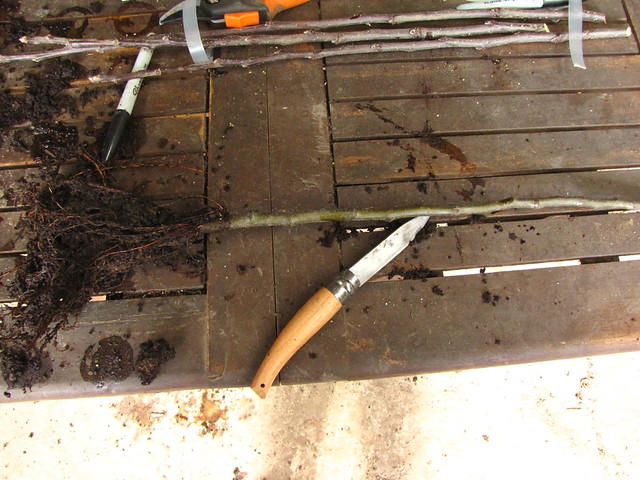 MM106 Rootstock by British Red, on Flickr
MM106 Rootstock by British Red, on Flickr
Step 4
Cut the root stock to a sharp angle in a single, flat clean cut.
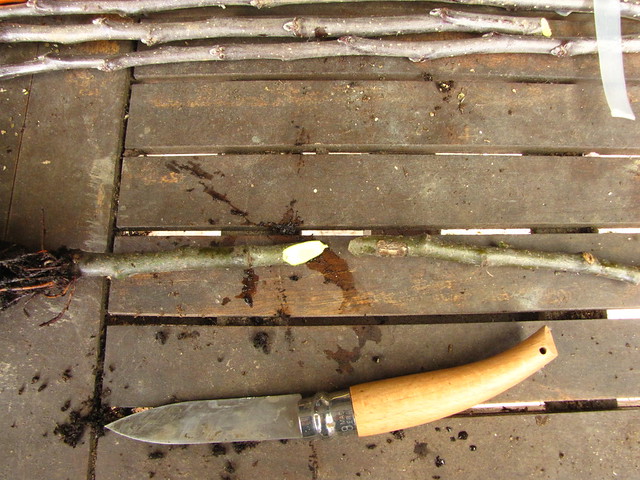 Cut Rootstock by British Red, on Flickr
Cut Rootstock by British Red, on Flickr
Step 5
Find a piece of scion wood the same diameter and cut to a matching angle
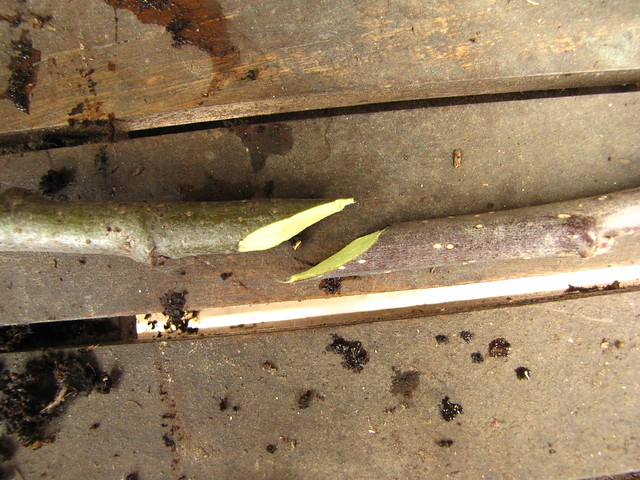 Cut Rootstock and Scion by British Red, on Flickr
Cut Rootstock and Scion by British Red, on Flickr
Step 6
On both the scion and the root stock, cut a deep nick in the angled face. These nicks will lock into each other when the graft is made. This is the "tongue"
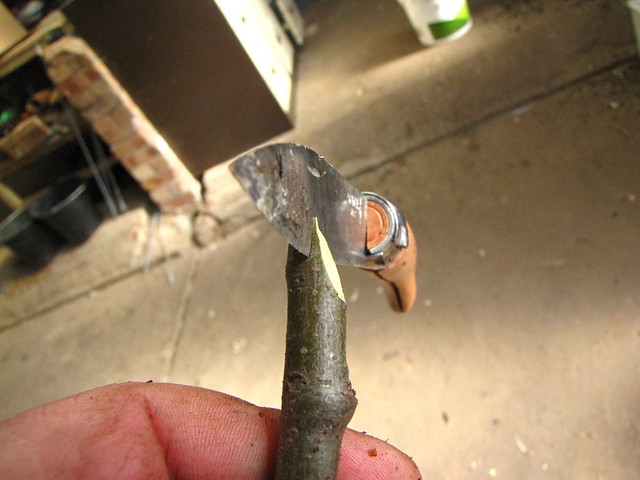 Cutting the tongue nick by British Red, on Flickr
Cutting the tongue nick by British Red, on Flickr
Step 7
Push the face of the scion wood over the fact of the root stock so that the tongues interlock
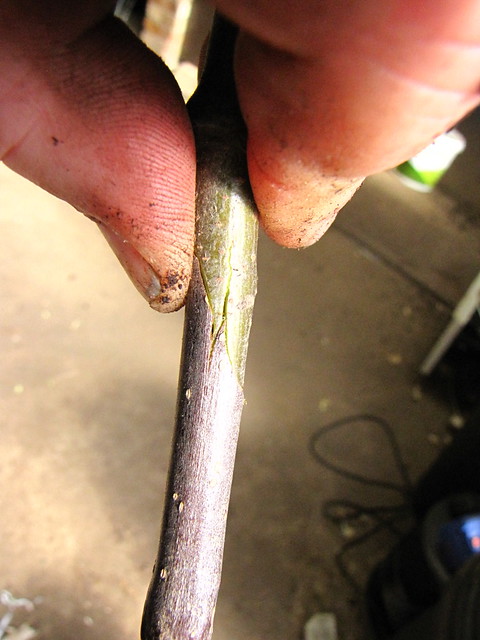 Joined Graft by British Red, on Flickr
Joined Graft by British Red, on Flickr
Step 8
"Whip" (tie) the graft together. I am using specialist grafting tape (£5 from Ebay), but a strip of freezer bag will work, just cut it off after a few months (you don't need to with grafting tape, it breaks down).
 Grafting Tape by British Red, on Flickr
Grafting Tape by British Red, on Flickr
Step 9
Make a label listing the scion, root stock and grafting date
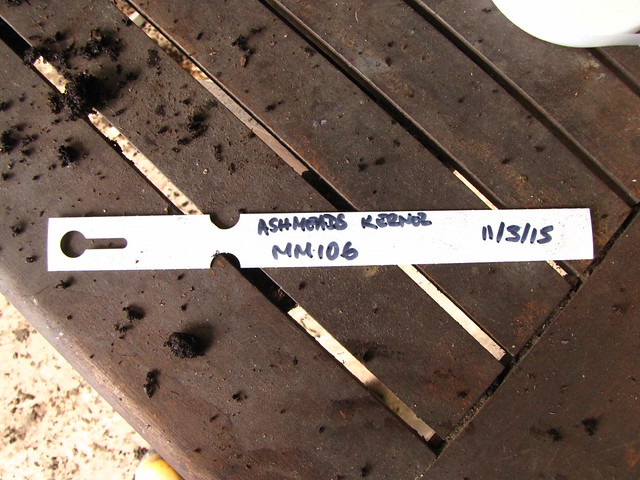 Tree Label by British Red, on Flickr
Tree Label by British Red, on Flickr
Step 10
Pot up your grafted tree and cross your fingers!
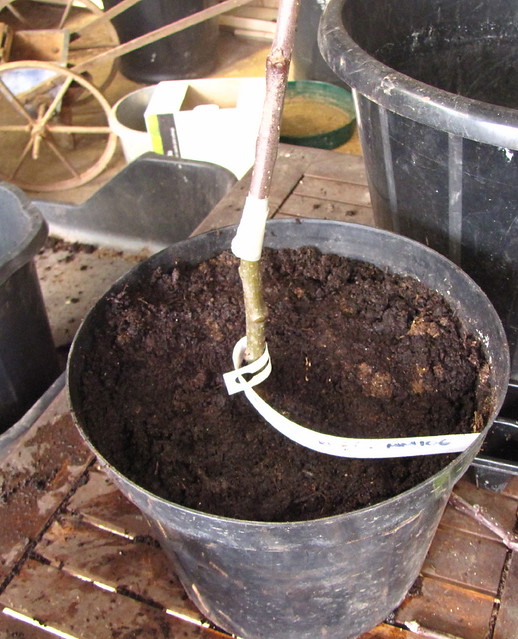 Grafted Tree in Pot by British Red, on Flickr
Grafted Tree in Pot by British Red, on Flickr
Hope that was interesting? Its the most basic form of grafting....but still seems like voodoo to me
However I know enough to realise that apples grown from pips do not grow true (being a hybrid of the tree and the pollinator), they also grow far too high making the fruit near impossible to pick. So I want to have grafted trees, its the whole paying for them thing I struggle with.
The only solution is to learn to graft our own.
I like an MM106 root stock on our apple trees. It grows a largish (12 foot) apple tree but keeps it manageable.
So I bought a few of these (and learned how to produce more, which I will cover in a separate post). You can get them for about £1.50 delivered though, so buying them is a lot cheaper than a £20 grafted fruit tree.
Here is how I went about grafting. I am using the whip and tongue graft here, but I will do some with a saddle graft if anyone is interested.
Step 1
Find a nice healthy apple tree with roughly pencil thick branches. This is best done in March as the tree wakes up
 Apple Tree by British Red, on Flickr
Apple Tree by British Red, on FlickrStep 2
With clean, disinfected secateurs, cut some of the branches of the tree you want. These are known as scions.
 Cut Scions by British Red, on Flickr
Cut Scions by British Red, on FlickrStep 3
Get your root stock of choice (mine have been stored planted in moist compost) and a very sharp, thin bladed knife. An opinel is perfect. Again disinfect.
 MM106 Rootstock by British Red, on Flickr
MM106 Rootstock by British Red, on FlickrStep 4
Cut the root stock to a sharp angle in a single, flat clean cut.
 Cut Rootstock by British Red, on Flickr
Cut Rootstock by British Red, on FlickrStep 5
Find a piece of scion wood the same diameter and cut to a matching angle
 Cut Rootstock and Scion by British Red, on Flickr
Cut Rootstock and Scion by British Red, on FlickrStep 6
On both the scion and the root stock, cut a deep nick in the angled face. These nicks will lock into each other when the graft is made. This is the "tongue"
 Cutting the tongue nick by British Red, on Flickr
Cutting the tongue nick by British Red, on FlickrStep 7
Push the face of the scion wood over the fact of the root stock so that the tongues interlock
 Joined Graft by British Red, on Flickr
Joined Graft by British Red, on FlickrStep 8
"Whip" (tie) the graft together. I am using specialist grafting tape (£5 from Ebay), but a strip of freezer bag will work, just cut it off after a few months (you don't need to with grafting tape, it breaks down).
 Grafting Tape by British Red, on Flickr
Grafting Tape by British Red, on FlickrStep 9
Make a label listing the scion, root stock and grafting date
 Tree Label by British Red, on Flickr
Tree Label by British Red, on FlickrStep 10
Pot up your grafted tree and cross your fingers!
 Grafted Tree in Pot by British Red, on Flickr
Grafted Tree in Pot by British Red, on FlickrHope that was interesting? Its the most basic form of grafting....but still seems like voodoo to me

